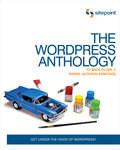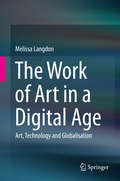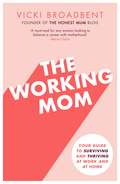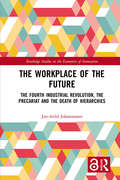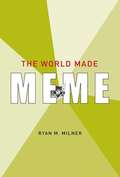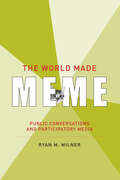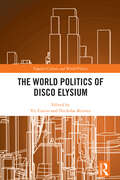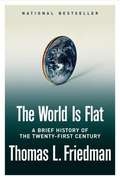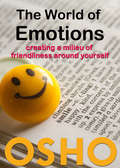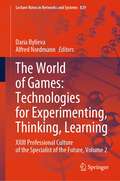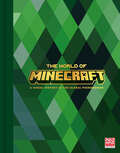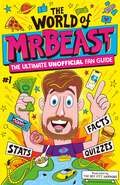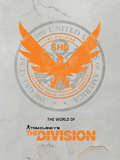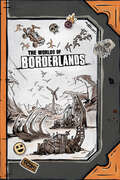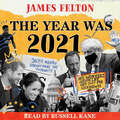- Table View
- List View
The Women of the Far Right: Social Media Influencers and Online Radicalization
by Eviane LeidigOn mainstream social media platforms, far-right women make extremism relatable. They share Instagram stories about organic foods that help pregnant women propagate the “pure” white race and post behind-the-scenes selfies at antivaccination rallies. These social media personalities model a feminine lifestyle, at once promoting their personal brands and radicalizing their followers. Amid discussions of issues like dating, marriage, and family life, they call on women to become housewives to counteract the corrosive effects of feminism and champion the Great Replacement conspiracy theory, which motivated massacres in Christchurch, El Paso, and Buffalo.Eviane Leidig offers an in-depth look into the world of far-right women influencers, exploring the digital lives they cultivate as they seek new recruits for white nationalism. Going beyond stereotypes of the typical male white supremacist, she uncovers how young, attractive women are playing key roles as propagandists, organizers, fundraisers, and entrepreneurs. Leidig argues that far-right women are marketing themselves as authentic and accessible in order to reach new followers and spread a hateful ideology. This insidious—and highly gendered—strategy takes advantage of the structure of social media platforms, where far-right women influencers’ content is shared with and promoted to mainstream audiences. Providing much-needed expertise on gender and the far right, this timely and accessible book also details online and offline approaches to countering extremism.
The WordPress Anthology: Get Under the Hood of Wordpress!
by Raena Jackson Armitage Mick OlinikWritten for developers, The WordPress Anthology will take you beyond the basics to give you a thorough overview of the WordPress universe. With a cookbook-style approach, you can pick and choose what you need from each chapter to suit your projects.Gain a comprehensive overview of installing, customizing and getting the most out of the web's most versatile content management systemDive into the inner mechanics of WordPress and make the code work the way you wantExplore the world of plugins, themes and APIs to add extra functionalityAdopt Multisite capabilities to host and manage your own centralized network of WordPress websitesLearn how to launch your application on a global scale with localization techniques and marketing tips
The Work of Art in a Digital Age: Art, Technology and Globalisation
by Melissa LangdonThis book explores digital artists' articulations of globalization. Digital artworks from around the world are examined in terms of how they both express and simulate globalization's impacts through immersive, participatory and interactive technologies. The author highlights some of the problems with macro and categorical approaches to the study of globalization and presents new ways of seeing the phenomenon as a series of processes and flows that are individually experienced and expressed. Instead of providing a macro analysis of large-scale political and economic processes, the book offers imaginative new ways of knowing and understanding globalization as a series of micro affects. Digital art is explored in terms of how it re-centers articulations of globalization around individual experiences and offers new ways of accessing a complex topic often expressed in general and intangible terms. The Work of Art in a Digital Age: Art, Technology and Globalization is analytic and accessible, with material that is of interest to a range of researchers from different disciplines. Students studying digital art, film, globalization, cultural studies or digital media trends will also find the content fascinating.
The Working Mom: The Honest Mum's Guide to Surviving and Thriving at Work and at Home
by Vicki BroadbentChosen by the Independent as one of the 10 best business books written by women'Vicki is one inspirational mumboss, who shares her secrets to juggling a thriving business with raising a family in this entertaining and empowering read!' Una Healy'Ideal for going back to work without losing your mind . . . a no-nonsense guide to navigating the transition' Marie Claire 'If ever there is a person who has shown just how successful you can be online whilst also being an amazing parent it is Vicki. Read, learn and follow. A brilliant book from an inspirational mother'. Natasha Courtenay-Smith, author of The Million Dollar BlogIn The Working Mom, Vicki Psarias, founder of HonestMum.com, shares her manifesto for surviving and thriving at work and at home. Vicki writes about everything from juggling work and family, to regaining your confidence after having a baby and battling imposter syndrome.An award-winning blogger and vlogger, in this book Vicki shares how to turn your passions into a business that suits the modern mum's lifestyle. The Working Mom is full of practical advice, tips and tricks to help fellow #mumbosses build their own business or return to work, while creating a personal brand and learning how to market yourself.Vicki's funny, fresh approach to life and work as a mum has brought her a loyal fanbase and a brilliantly successful business: her blog Honest Mum is one of the UK's most popular parenting and lifestyle sites, and the blog combined with Vicki's social channels has an average monthly reach of 1 million. A Lean In for the blogging and vlogging generation, The Working Mom is an essential book for all parents, whether they are returning to work or looking to start a new career, as well as anyone looking to build their brand or business online.'A must-read for the modern Mum; particularly one who has aspirations to build her own business. I wish I had been able to read it three years ago!' Katie Massie-Taylor, Co-Founder, Mush
The Working Mom: The Honest Mum's Guide to Surviving and Thriving at Work and at Home
by Vicki BroadbentChosen by the Independent as one of the 10 best business books written by women'Vicki is one inspirational mumboss, who shares her secrets to juggling a thriving business with raising a family in this entertaining and empowering read!' Una Healy'Ideal for going back to work without losing your mind . . . a no-nonsense guide to navigating the transition' Marie Claire'If ever there is a person who has shown just how successful you can be online whilst also being an amazing parent it is Vicki. Read, learn and follow. A brilliant book from an inspirational mother'. Natasha Courtenay-Smith, author of The Million Dollar BlogIn The Working Mom, Vicki Psarias, founder of HonestMum.com, shares her manifesto for surviving and thriving at work and at home. Vicki writes about everything from juggling work and family, to regaining your confidence after having a baby and battling imposter syndrome.An award-winning blogger and vlogger, in this book Vicki shares how to turn your passions into a business that suits the modern mum's lifestyle. The Working Mom is full of practical advice, tips and tricks to help fellow #mumbosses build their own business or return to work, while creating a personal brand and learning how to market yourself.Vicki's funny, fresh approach to life and work as a mum has brought her a loyal fanbase and a brilliantly successful business: her blog Honest Mum is one of the UK's most popular parenting and lifestyle sites, and the blog combined with Vicki's social channels has an average monthly reach of 1 million. A Lean In for the blogging and vlogging generation, The Working Mom is an essential book for all parents, whether they are returning to work or looking to start a new career, as well as anyone looking to build their brand or business online.'A must-read for the modern Mum; particularly one who has aspirations to build her own business. I wish I had been able to read it three years ago!' Katie Massie-Taylor, Co-Founder, Mush
The Working Mom: The Honest Mum's Guide to Surviving and Thriving at Work and at Home
by Vicki BroadbentChosen by the Independent as one of the 10 best business books written by women'Vicki is one inspirational mumboss, who shares her secrets to juggling a thriving business with raising a family in this entertaining and empowering read!' Una Healy'Ideal for going back to work without losing your mind . . . a no-nonsense guide to navigating the transition' Marie Claire 'If ever there is a person who has shown just how successful you can be online whilst also being an amazing parent it is Vicki. Read, learn and follow. A brilliant book from an inspirational mother'. Natasha Courtenay-Smith, author of The Million Dollar BlogIn The Working Mom, Vicki Psarias, founder of HonestMum.com, shares her manifesto for surviving and thriving at work and at home. Vicki writes about everything from juggling work and family, to regaining your confidence after having a baby and battling imposter syndrome.An award-winning blogger and vlogger, in this book Vicki shares how to turn your passions into a business that suits the modern mum's lifestyle. The Working Mom is full of practical advice, tips and tricks to help fellow #mumbosses build their own business or return to work, while creating a personal brand and learning how to market yourself.Vicki's funny, fresh approach to life and work as a mum has brought her a loyal fanbase and a brilliantly successful business: her blog Honest Mum is one of the UK's most popular parenting and lifestyle sites, and the blog combined with Vicki's social channels has an average monthly reach of 1 million. A Lean In for the blogging and vlogging generation, The Working Mom is an essential book for all parents, whether they are returning to work or looking to start a new career, as well as anyone looking to build their brand or business online.'A must-read for the modern Mum; particularly one who has aspirations to build her own business. I wish I had been able to read it three years ago!' Katie Massie-Taylor, Co-Founder, Mush
The Workplace of the Future: The Fourth Industrial Revolution, the Precariat and the Death of Hierarchies (Routledge Studies in the Economics of Innovation)
by Jon-Arild JohannessenThe Fourth Industrial Revolution is a global development that shows no signs of slowing down. In his book, The Workplace of the Future: The Fourth Industrial Revolution, the Precariat and the Death of Hierarchies, Jon-Arild Johannessen sets a chilling vision of how robots and artificial intelligence will completely disrupt and transform working life. The author contests that once the dust has settled from the Fourth Industrial Revolution, workplaces and professions will be unrecognizable and we will see the rise of a new social class: the precariat. We will live side by side with the 'working poor' – people who have several jobs, but still can’t make ends meet. There will be a small salaried elite consisting of innovation and knowledge workers. Slightly further into the future, there will be a major transformation in professional environments. Johannessen also presents a typology for the precariat, the uncertain work that is created and develops a framework for the working poor, as well as for future innovation and knowledge workers, and sets out a new structure for the social hierarchy. A fascinating and thought-provoking insight into the impact of the Fourth Industrial Revolution, The Workplace of the Future will be of interest to professionals and academics alike. The book is particularly suited to academic courses in management, economy, political science and social sciences.
The World Made Meme: Public Conversations and Participatory Media
by Ryan M. MilnerInternet memes -- digital snippets that can make a joke, make a point, or make a connection -- are now a lingua franca of online life. They are collectively created, circulated, and transformed by countless users across vast networks. Most of us have seen the cat playing the piano, Kanye interrupting, Kanye interrupting the cat playing the piano. In The World Made Meme, Ryan Milner argues that memes, and the memetic process, are shaping public conversation. It's hard to imagine a major pop cultural or political moment that doesn't generate a constellation of memetic texts. Memetic media, Milner writes, offer participation by reappropriation, balancing the familiar and the foreign as new iterations intertwine with established ideas. New commentary is crafted by the mediated circulation and transformation of old ideas. Through memetic media, small strands weave together big conversations. Milner considers the formal and social dimensions of memetic media, and outlines five basic logics that structure them: multimodality, reappropriation, resonance, collectivism, and spread. He examines how memetic media both empower and exclude during public conversations, exploring the potential for public voice despite everyday antagonisms. Milner argues that memetic media enable the participation of many voices even in the midst of persistent inequality. This new kind of participatory conversation, he contends, complicates the traditional culture industries. When age-old gatekeepers intertwine with new ways of sharing information, the relationship between collective participation and individual expression becomes ambivalent. For better or worse -- and Milner offers examples of both -- memetic media have changed the nature of public conversations.
The World Made Meme: Public Conversations and Participatory Media (The Information Society Series)
by Ryan M. MilnerHow memetic media—aggregate texts that are collectively created, circulated, and transformed—become a part of public conversations that shape broader cultural debates.Internet memes—digital snippets that can make a joke, make a point, or make a connection—are now a lingua franca of online life. They are collectively created, circulated, and transformed by countless users across vast networks. Most of us have seen the cat playing the piano, Kanye interrupting, Kanye interrupting the cat playing the piano. In The World Made Meme, Ryan Milner argues that memes, and the memetic process, are shaping public conversation. It's hard to imagine a major pop cultural or political moment that doesn't generate a constellation of memetic texts. Memetic media, Milner writes, offer participation by reappropriation, balancing the familiar and the foreign as new iterations intertwine with established ideas. New commentary is crafted by the mediated circulation and transformation of old ideas. Through memetic media, small strands weave together big conversations. Milner considers the formal and social dimensions of memetic media, and outlines five basic logics that structure them: multimodality, reappropriation, resonance, collectivism, and spread. He examines how memetic media both empower and exclude during public conversations, exploring the potential for public voice despite everyday antagonisms. Milner argues that memetic media enable the participation of many voices even in the midst of persistent inequality. This new kind of participatory conversation, he contends, complicates the traditional culture industries. When age-old gatekeepers intertwine with new ways of sharing information, the relationship between collective participation and individual expression becomes ambivalent. For better or worse—and Milner offers examples of both—memetic media have changed the nature of public conversations.
The World Politics of Disco Elysium (Popular Culture and World Politics)
by Nicholas Kiersey Vic CastroThe World Politics of Disco Elysium analyzes the distinctive political claims and original arguments on a wide range of international political issues of the highly-acclaimed Marxist video game Disco Elysium (2019), which takes place in a speculative fictional world anchored in a post-Soviet Estonian perspective.Disco Elysium (2019) has been repeatedly acclaimed as one of the best video games of all time. This detective role-playing game unfolds in a city ruined by a failed communist revolution and occupied by a foreign coalition. Furthering recent work in International Relations and popular culture, this book claims that the "cognitive estrangement" of speculative fiction can produce theoretical and political novelty, beyond merely reflecting existing political dynamics. By placing a metaphor for the Estonian capital Tallinn at the centre of a world, Disco Elysium produces an estranged Estonian perspective on world politics that challenges dominant Anglo-American views of International Relations, while also undermining the opposition between a coherent West and a colonized Rest. The contributors, from International Relations and Cultural Studies, discuss the game’s claims on topics such as capitalism, (neo)liberalism, foreign intervention, law enforcement, fascism, colonialism, gender, disability, violence, memory, revolutionary politics, the European Union, political realism and international security.The World Politics of Disco Elysium will be of great interest to students and scholars researching the politics of popular culture, post-Soviet politics, non-Western International Relations, as well as game studies and cultural studies.
The World Wide Web: A Mass Communication Perspective
by Barbara K. Kaye Norman J. MedoffThrough an approach that is both conceptual and practical, this text helps mass communication and broadcast students understand the value and commercial uses of the World Wide Web in the mass communication professions. Students will learn to think critically about social, legal, and ethical issues related to the world wide Web, and they will get practical information about how different media domains (radio, TV, public relations, advertising) are currently using the Web for both marketing and content purposes.
The World Wide Web: A True Book
by Larry Dane BrimnerA basic overview of the World Wide Web, including the history of its development and details on how to use it.
The World is Flat: A Brief History of the Twenty-first Century
by Thomas L. FriedmanWhen scholars write the history of the world twenty years from now and they come to the chapter "Y2K to March 2004", what will they say was the most critical development? The attacks on the World Trade Center and the Pentagon on 9/11 and the Iraq War? Or the convergence of technology and the events that allowed India and China and so many other countries to become part of the global supply chain for services and manufacturing. And with this flattening of the globe,which requires us to run faster in order to stay in place, has the world gotten too small and too fast for human beings and their political systems to adjust in a stable manner.
The World of Assassin's Creed Valhalla: Journey to the North--Logs and Files of a Hidden One
by Rick BarbaA full-color, oversized hardcover tome that chronicles Viking culture, history, lore, and mythology amid the action and drama of Assassin&’s Creed Valhalla.Ubisoft and Dark Horse Books present The World of Assassin's Creed Valhalla, a journal kept by Hytham himself, which allows readers to experience Assassin&’s Creed Valhalla as they've never seen before.Discover the history and culture of the Raven Clan Vikings as they struggle against the Order of the ancients. Get an in-depth view at the setting of the game with descriptions and depictions of in-game characters and locals as the Vikings move from Norway to England, Ireland, and Francia. What best-kept secrets will you uncover at Hytham&’s side?
The World of Cyberpunk 2077
by Marcin BatyldaAn insightful, captivatingly designed, full-color book that transports readers to the futuristic megalopolis of Night City--the epicenter of the vibrant new action-RPG from CD Projekt Red.Step into the year 2077, a world dotted with dystopian metropoles where violence, oppression, and cyberware implants aren't just common--they're necessary tools to get ahead. Delve into incisive lore to discover how the economic decline of the United States created a crippling dependence on devious corporations and birthed the Free State of California. Explore the various districts, gangs, and history of Night City. Learn all there is to know about the technology of tomorrow and research the cybernetics, weapons, and vehicles of Cyberpunk 2077. Dark Horse Books and CD Projekt Red present The World of Cyberpunk 2077--an extensive examination of the rich lore of Cyberpunk 2077. This intricately assembled tome contains everything you need to know about the history, characters, and world of the long-awaited follow-up from the creators of The Witcher video game series.
The World of Dual-Brain
by Weizhi ZhangThis book leaves the template of the inertia of natural human society and traditional ideological thinking, to illustrate the mechanism of the generation of the Sociality Brain and to explore the construction path of the human-computer symbiosis order. At the same time, this book proposes concepts including ‘wisdom sharing system’, ‘the Sociality Brain’, ‘dual-brain world’, ‘off-site economic civilization’, ‘basic contradictions in the intelligent world’, and ‘class analysis and division of the dual-brain world’, etc. This is a philosophical thinking about the intelligent world beyond the categories of natural human society and biological brain.
The World of Emotions
by Osho International Foundation OshoThe World of Emotions: A unique set of tools for everybody who is interested in improving human relations, and a great help in understanding where we are all coming from and what makes us tick. Full of simple, practical suggestions for creating a milieu of friendliness around yourself that is honest, sincere, and accepting of all our human frailties. One of the greatest challenges we face in life is learning how to handle and transform emotions. In this small book, Osho takes the reader step by step toward a deeper understanding of the inner world of emotions - where they come from, what types of situations can trigger them, and why they so often take us by surprise. We are taught that anger is bad, and we resolve not to be angry - but still it happens! Why is that? The first step in understanding is to identify and become aware of the conflicts between our intellectual understandings and the emotional realities that so often dominate our lives, between what we think and what we what we feel. Once the roots of this conflict are clearly seen and understood, the split can be healed. And the powerful life
The World of Games: XXIII Professional Culture of the Specialist of the Future, Volume 1 (Lecture Notes in Networks and Systems #830)
by Alfred Nordmann Daria BylievaThis book reflects the various dimensions of play. It gathers together experience with role-play, tabletop, and online games and develops and assesses tools. It also reflects the human condition in this world of games as it becomes a digital world. We are living in a World of Games where every game is a world through which we learn about the world. A World of Games is fun and engaging, but it also provides deceptive pleasures. What may seem like fun is far from harmless. And then there are the many ways of learning in the mode of play.
The World of Games: XXIII Professional Culture of the Specialist of the Future, Volume 2 (Lecture Notes in Networks and Systems #829)
by Alfred Nordmann Daria BylievaThis book reflects the various dimensions of play. It gathers together experience with role-play, tabletop, and online games and develops and assesses tools. It also reflects the human condition in this world of games as it becomes a digital world. We are living in a World of Games where every game is a world through which we learn about the world. A World of Games is fun and engaging, but it also provides deceptive pleasures. What may seem like fun is far from harmless. And then there are the many ways of learning in the mode of play.
The World of Minecraft (Minecraft)
by Mojang ABUncover the history of one of the most influential games of all time in The World of Minecraft. Explore how the critically acclaimed game evolved from a one-person project in 2009 to the global gaming phenomenon it is today. The World of Minecraft is the definitive account of the game&’s history, combining exclusive interviews from the Mojang studio and recollections from long-standing members of the gaming community. Read the stories behind mods like Feed The Beast, the growth of community-defining servers like Hypixel, and YouTube channels like The Yogscast, plus a personal account from Lydia Winters on the creation of Alex, the impact of Minecraft charity Block by Block, the origin of the phantom, and many more insights.This must-have collector&’s item includes a foreword from chief creative officer Jens &“Jeb&” Bergensten and an afterword from vanilla Minecraft game director Agnes Larsson, plus original concept art, beautifully detailed renders, and previously unseen archive materials that illustrate how the game has developed over its first fifteen years. Journey back into past eras of the game and look to the future in this comprehensive chronicle of Minecraft&’s story.
The World of MrBeast: The Ultimate Unofficial Fan Guide Packed with Facts, Stats and Quizzes (The World Of #1)
by Catherine Saunders*THE ULTIMATE UNOFFICIAL MRBEAST FAN BOOK*Discover everything there is to know about MrBeast, the biggest YouTuber the world has ever known. Follow his journey from the early days of posting gaming videos from his bedroom, to becoming the viral, worldwide sensation that he is today. Whether he's building his very own Willy Wonka's Chocolate Factory and covering people in slime, or donating millions in aid to refugees, uncover the secrets behind MrBeast's most sensational giveaways, spectacular stunts, million-dollar challenges and the inspirational videos that are helping people around the world. Put your knowledge to the test with quick quizzes, impress your friends with the most amazing quotes, and discover record-breaking stellar stats that prove that Mr Beast is the internet's biggest star!*This book has not been authorised, licensed or endorsed by MrBeast or any associated entity, nor by anyone involved in the creation or production of the MrBeast YouTube channel.Buy this book if you're looking for:- gifts for boys and girls aged 8, 9, 10, 11- a book to get kids more interested in reading- a kid-favourite gift for birthdays, holidays or Christmas or summer holidays- a book that will inspire the biggest MrBeast and YouTuber fans in your life
The World of Tom Clancy's The Division
by UbisoftIncisive lore and detailed art in a cunningly designed hardcover that will bring readers into the ravaged streets of New York City and Washington DC as seen in Ubisoft's record-breaking videogame series!On Black Friday, a deadly biological attack was thrust upon the populace of New York. Within weeks, millions lay dead, and the city was placed under quarantine. The only force with any hope of restoring order are the embedded agents of the SHD--more commonly known as the Division. Despite the quarantine, the infection continues to spread across the country. Amidst a ruined government, a shattered infrastructure, and an eroding civilization, the Division is now called to action in Washington DC--but if the agents fail, the capital will fall, and the nation with it.The World of Tom Clancy's The Division is the meticulously crafted result of a partnership between Dark Horse books and Ubisoft Entertainment, offering readers a unique insight into the chaotic and dangerous world of the hit games. Don't miss this opportunity to learn all there is to know about the tactical methods, the high-tech tools, and the all-important mission of the Division!
The World of the Witcher: Video Game Compendium
by CD Projekt RedDive deep into the world of monster hunters, as the prominent characters from the universe take you on a guided tour of the fascinating dark fantasy adventure that is The Witcher. This gorgeous, illustrated hardbound volume contains in-depth knowledge about the locales, the deadly beasts that inhabit them, and the lethal weapons used to put them down.
The Worlds of Borderlands
by Rick BarbaExplore a universe run amok with savage beasts, bloodthirsty bandits, and the biggest bad of all—corporations, in this full-color hardcover encyclopedia of Gearbox&’s beloved videogame franchise!The universe of Borderlands is an inhospitable wilderness that spans every biome conceivable. It&’s also a land full of opportunity, but only if you have wits, skill, and guns. Lots of guns. Many come to Pandora in search of the Vault in the hopes of finding wealth, fame, or power. This is the definitive guide to the bold people who live there and in the surrounding galaxy, the mercenaries, monsters, and wilds they contend with, and the ridiculous arsenal they employ.Dark Horse Books and Gearbox present The Worlds of Borderlands—a bombastic guide to Pandora, its surrounding planets and the characters who live there. This volume is filled with art and trivia relating to the guns, vehicles, ships, companies, and adventurers of the worlds-spanning universe—and the monstrous fauna who would eat all of them.
The Year was 2021: A review of the news, culture and cancellations that made people laugh, cry and very, very cross
by James FeltonA hilarious review of the rollercoaster ride that was 2021 from Twitter legend and bestselling author of 52 TIMES BRITAIN WAS A BELLEND, covering the good, the bad and the downright bonkers news and culture stories from the year.You might have forgotten (or wanted to forget) the storming of the Capitol, the Meghan and Harry interview with Oprah, Dominic Cummings turning on his former master and *that* bum squeeze by Matt Hancock - but James Felton is here to remind listeners of all of that and more using his usual razor-sharp wit and gleeful disdain. Whether you're after some painfully funny company on your commute, or want to chuckle/become enraged on the way to visiting loved ones over the festive period, THE YEAR WAS 2021 reminds us all just how ridiculous the last 12 months have been - and prepares us for the onslaught of 2022...

